This workshop took place in Bastide sur l'Hers in a beautiful house from friends of us, and we had a wonderful space to work in and each had a bedroom for his/her own.
Jon, an old friend of us from England, arrived a few days earlier and so helped to set everything up (Thank you!) Ricardo and Isabel from Spain arrived at around 16.00, but Vladimir (Latvia)) and Karin (Dutch, but living in Finland) only arrived at around 19.00.
However Tee, my daughter in law, had prepared an excellent Thai meal.
After dinner we introduced each other and went through some practicalities (rota for making supper etc)
Sunday; Lac Montbel
Morning session
1. Made drawing of 'our landscape', where we grew up or where we lived or what landscape impressed us
2. Introduced some pictures/drawings in order to become conscious how we see or look at things.
Lac Montbel
Outdoor session; We first went to the north side of the lake and focused on the view facing south towards the high mountains. Some of us also took the opportunity to go for a swim.
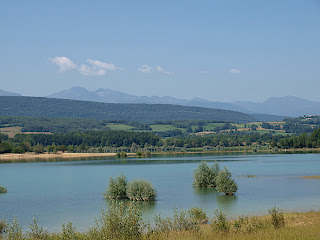
Then, after coffee(!) we went to the other side of the lake and this time we went our separate ways, but generally faced north. Afterwards had picnic lunch and shared our experiences.
We soon realised that we all looked at different aspects, not only because we have different interests, but also because of our knowledge (geology, agriculture e.g) or experience (to have lived there) but once we shared our experiences each came to a more complete and comprehensive picture.
Some of our observations;
The yellow between water and islands looked like sand, but it was clay.
How would the landscape look like if there was not a village, from where people had created the fields and cultivated several different crops? Boring?
There was a ridge of hills from east to west with a gap in it. This ridge is not only a physical boundary but also a cultural boundary between mountain culture and the lowland culture.
The further you looked the colours become more hazy. Mountains are more or less greyish blue.
 Late afternoon session
Late afternoon session
What aspects do we see in the landscape?
Introduced Landscape conceptional models from the work of Jan Diek van Mansvelt and Benedetta Castiglioni (see
Landscape page)
Main ideas; Landscape is a combination of natural and cultural factors.
What we see as image is the result of these factors, but what we notice is determined by our interests/intentions.
Also introduced the European Landscape Convention (see ELC)
Supper; This was prepared by Adriaan and Jon and soon realised that we were short of time. So for the next days we added half an hour for preparation of the meals.
Evening session
Introduces the work 'Legible Landscape', a dutch manual for landscape character assessment, based on the thesis by Karina Hendriks and Dirk Jan Stobbelaar, which is often used for landscape walks or projects in Holland to enhance participation in landscape development.
Adriaan had translated this work, but had also prepared a key-note presentation.
We went through the manual, but this did not work out so well as he thought. The key-note presentation might have worked out better. Ah... well, next time!
However we all understood that we can look at the landscape from different perspectives and the next few days during our walks we concentrated on the vertical(why do these plants grow there), horizontal(paths, roads, watercourses), seasonal(what time of year are we?) and historical (what has taken place here?) dimensions of the landscape.
Karin soon came to realise however that sounds were absent in the manual and of course this is a very important item in landscape experience.
Monday Gorges de la Frau
After a short introduction to the theme of day (Plant observation in the Gorges and Legible Landscape session in Pays d'Aillou), we went of to the starting point of our fairly long walk!
After a very short introduction about plant growth we walked up the Gorges with the task of not talking (!) and observing the many different forms plant can create and we were to choose to draw one plant.
When we came out of the Gorges we still had a fair way to go to enjoy a cup of coffee at a very nice place in Comus.
Then we walked through beautiful hayfields with a great variety of flowers direction Montaillou, but we stopped half way and found a good picnic spot from where we could see Prades, but from Montaillou only the castle ruin. Some of us walked a little bit further and we could just see the church below Montaillou.
 |
| Walked to and had picnic lunch on top of the little hill in the middle of the photo. |
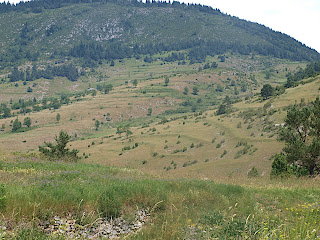 |
| Terraced? |
 |
| View from our picnic place |
We were rather tired from the walk, some of us are getting on a bit, and so we did not manage to do a 'Legible Landscape' session.
On the way back we had another coffee and shared our plant drawings.
Then on our way back we had the wonderful experience of clouds appearing over the mountains and later out of the Gorges.
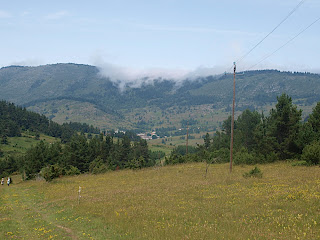 |
| View back to direction Comus |
Afternoon session
Introduction to plant metamorphosis mainly with help of the work done by Jochen Bockemuhl
and in relation to tree growth on resp south and north facing slopes.
However because most of us were already partly acquainted with it, we didn't spend much time over it.
Supper; A delightful and exotic meal prepared by Ricardo and Isabel. Thank you!
Evening Session
Introducing the work of David Seamon (Geography of the Life World) and Tim Ingold ('Stop, look and listen' from the book 'Perception of the Environment')
We spend most of the time on David Seamon and read an extract about the body-subject and its
This was at the same time a good introduction to the work of Merleau-Ponty.
At the end of the evening I gave two papers, one with exercises in relation to the senses and my Goethean Essay (see
My Articles), what is actually also an exercise in relation to the senses.
Tuesday Puivert
Morning session
Introducing the senses; We did the exercise in relation to the senses, which is based on the work of Richard Box 'Drawing; a course for the fearful or terrified”! and then elaborated on by Adriaan.
We became aware, especially in relation to sound, that we don't have to hear sounds in our ears, but there where the sounds are coming from! Is this not the same we can do (intend) when we see things?
In reality we can zoom in on certain areas and then we see things more clearly.
Also we became aware that we don't see 'things', but only shades of colour but because we move our eyes along edges we become aware of form. The rest we add, partly because of other sense-perceptions of past experiences (touch etc), but mostly we add concepts (tree, rocks, houses etc).
Another question came up; are airwaves the same as sound and are electromagnetic waves the same as colour?
I hope I managed to show that this is not the case!
We realised that we could go on for a long time but we decided to leave it at that for tonight!
So off to Puivert and concentrate on a 'Legible Landscape' session.
Puivert
From where we were went, we could see Puivert in the distance (in the gap between the 2 hills) and just on the right you can just see Puivert Castle. More on the right (not on photo) is the village where we went to see the farmer and he showed us his barn and shed in the middle of the village, where he keeps his cows and sheep.
Jon and Vladimir (on a haybale) are drawing while I made the coffee! This time the task was 'Legible Landscape' so we looked at the vertical dimension (why do certain plants grow on this spot) horizontal dimension (outlay of roads, watercourses, hedges), seasonal dimension (which time of year are we) and the historical dimension (what features are there from what time)
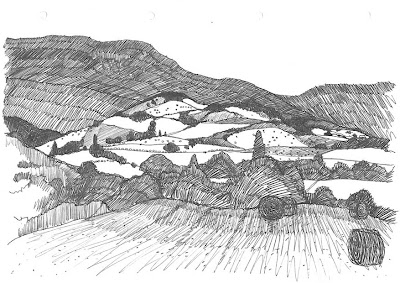 |
| View facing west (by Vladimir) |
Afterwards we had a peaceful lunch (and a swim!) at the lake on the edge of Puivert and after lunch we went to visit the castle, which at the same time gave us opportunity to have excellent views of the surroundings.
Driving through the village on the way to the castle, we noticed 'old' toilets on the middle of the bridge.
 |
| Puivert; Main entrance |
|
|
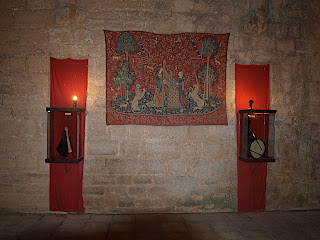 |
| Music room |
 |
| In the morning we were just on the other side, at the foot of the mountains |
 |
| Puivert village and lake |
On the way back we talked about the troubadours and the general cultural situation around medieval times.
Afternoon session
After shopping we had a game session;
1) Putting about 12 photos of the same landscape in chronological order.(and not only of over one year period!)
2) Putting pictures of branches in the right position. How do we know in which position they grew on the tree?
Supper; Another excellent supper prepared by Karen and Vladimir
Evening Session
Introduced the work of Georg Maier and his colleagues by reading first the introduction 'Two smiles" of the book 'Matter and Mind' (new title 'Marriage of Sense and Thought') (see
Goethean Science)
Then introduced the work '
Being on Earth, Tending the Appearances' specially the chapters in relation to Aesthetics and Baumgarten.
However I soon trailed off to the idea that what we see depends not only on our intentions, but even on our organism, and that can easily lead to the opinion that the world we see is our own creation and sounds and colours are not existing independently of us. (neither matter!)
Karen put her foot in this and Jon supported her, but Ricardo partly supported my idea.
However we all agreed that we were partly both right, but we needed to workout upon on what aspects we were talking about. Ricardo and me realised that there is indeed something added to the world
when we are focussing on an appearrance, first the experience, secondly we meet the object with
a general concept to meet the unique appearance with its specific, inherent concept.
(I will come back to this problem sometime as I have occupied my self with this since)
So we jumped from Aesthetics straight to the subject of the next day and we read Owen Barfield's first chapter of “Saving the Appearances” called 'Rainbow' (see Post nov 2010) before we went to bed.
However I think the idea came over that in daily life we first have an aesthetic experience (experiencing the whole) where from we can select certain aspects, but then we should not forget to put it back into the whole and realise we can look at different aspects another time.
Also I felt that from this evening onwards all of us became more engaged and made the workshop successful.
Wednesday Lac Soulcem
Morning Session
Read Owen Barfield's "Rainbow” article and the next chapter (not helpful I think) and this was supplemented by a short part of Georg Maier's writing in relation that we can't have it both ways. (Cat and mouse)
Colour and matter are
both objectively present, but we experience them in our way (that is as human beings) that is through the senses (resp colour and resistance) and through thought (natural laws)
But our thoughts are not coming by themselves, we have to be actively involved. But we can also leave it and walk past. Also we experience the world through feelings, each landscape has a certain atmosphere. What is it out there what resonates in us. It is not only visual, but something elemental?
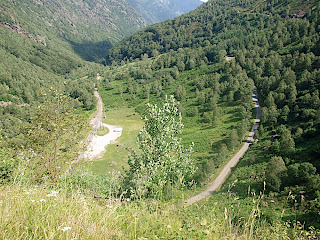 |
| Lac Soulcem; The way we came from |
|
|
|
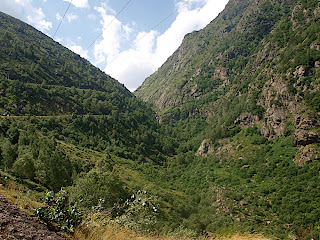 |
| Where we have to go through | | | | |
|
 |
| Next stage; Where we came from |
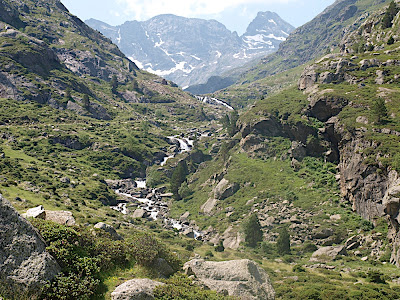 |
| Where we go to (walking this time!) |
 |
| Shepherd's huts on the way |
 |
| Where are the cows and horses? |
 |
| End of the world? |
 |
| Jon facing the hight mountains |
 |
| Ricardo and Isabel facing to and away from the mountains |
Supper; A reasonable supper prepared by our host Betsy and Adriaan.
Evening session
Can't remember exactly but we continued our discussion from the morning, and it was to explore what is our connection with nature, which expresses itself in all kinds of forms, shapes and sizes etc.
We feel there is a connection between us and them (plants, animals landscape) and I brought the image that during world=man's evolution plant and animals separated to early/incarnated to early (from a certain point of view!), but they were part of our humanity. Is this why we feel connected with them. Same roots?
Suggested reading before going to bed; Owen Barfield's chapter how people in mediaeval times experienced the world in comparison with how we experience it. (from 'Saving the appearances', see
Evolution of Consciousness)
Thursday Plateau du Sault
Morning session
Introduction to the phenomena that during the Middle Ages, arable farming, animal husbandry, vegetable and fruit growing were for the first time integrated into a unity and the main cultural impulse in the west was Christianity which radiated from the centre of the village(church) for many years to come.
These landscapes we now observe as the aesthetic harmonious landscapes all over Europe. Around the village the fruit and vegetable growing then further out the animals and then the arable fields and then further afield(!) other fields (hay) and then at the border of the communities the forests.
Only recently landscapes have became fragmented.
Plateau du Sault
We went to the village Rodome and from there did a 'legible landscape' walk, that is we looked from several different perspectives. We saw some kind of cereal which was a cross between rye and wheat.
This time we also wanted to explore architectural features so at the end of our walk we went into the village and made some drawings.
 |
| On the way out of the village (field with oats) |
 |
| Notice the many small but well looked after fields |
 |
| South facing slope with beehives |
During our walk we came to the conclusion that this was a highly 'Legible Landscape' as nearly all features came out of the landscape itself with nearly no foreign elements present.
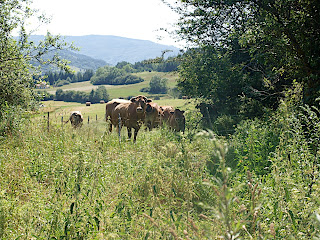 |
| Cows at last! |
We met a farmer and he explained this was not wheat, neither rye but a cross between them and was used for breadmaking. Vladimir brought to our attention that one can just look at shadows and notice that they can tell us a lot about time of day, year and where we are on earth (south or north etc)
Vladimir brought to our attention that one can just look at shadows and notice that they can tell us a lot about time of day, year and where we are on earth (south or north etc)
 |
| Shadows! Why do you make the arch Gothic, Vladimir? |
|
|
 |
| Lunch |
 |
| Valley behind, towards the Gorges d'Aude |
Valley behind towards the Gorges the Aude, which is just behind the end of the field, but about several hundred meters down! At the end of this field we found this stone; on one side the languedoc cross and on the other side the lily.
Back home and this time Karin and Vladimir prepared the main meal and Ricardo and Isabel a fantastic cold soup.
Evening session
A key-note presentation of the history of Landscape Painting from the middle ages to around the beginning of the last century. This was also attended by our host and family of Adriaan.
Main features of History of Art
• Painting was 2 dimensional and depicted spiritual subjects
• First landscape around 1400 and then from that time onwards the Flemish and Dutch artist eyes opened their eyes to the sense-perceptible world around us. And depicted the world as we see it now (Vermeer) including daily life and people.
 |
| Small detail of Flemish religious painting |
• Later the reverence to the Gods was replaced by reverence to Nature (Romanticism; Friedrich)
• With Impressionism people became aware of the momentary dimension (Aesthetic) of our perceptions (Monet) and experimented with colour to express the impression it made on them or to express the essentials of a landscape.(Cezanne, van Gogh)
• And this led to Expressionism with many diverse forms, but one characteristic is that it led again to 2 dimensional painting. And that is what a painting is! Frans Marc, Picasso, Kadinsky, Klee, Munch etc
• At that same time photography came up and here it becomes very clear that photos depict a highly 'aesthetic' picture as it depicts a scene at one particular moment (1 second?)
Friday Carcassonne
Morning session
Brief introduction to medieval history; development of fortified villages and cities.
Carcassonne
Went to Carcassonne via the backroad
Walked around, mainly between the inner and outer wall, had coffee and then each went his own way to do a drawing/observation exercise.
Castle within La Cite
Where are the tourists?
 |
| Castle within La Cite |
 |
| Where are the tourists? |
After a good lunch we drove back but on the way we drove through La Force, where the houses were build in a circle and then we stopped at to fields to see Jon's sunflowers
and then we stopped at Fanjaux where we had spectacular views of the landscape with many clear pattern. We could have spend there a long-time.
 |
| View from Fanjaux |
When we arrived home Karen prepared another substantial meal and in between we shared our drawings and read in our own time an extract from Tim Ingold's article 'Stop, look and listen' (see
Phenomenology page) which was another good introduction to the work of Merleau-Ponty.
Evening session
Introduced some of the work done by others in relation to how people in the past (but partly also present day hunters and gatherers) lived within the landscape, for example Gurevich, Goff and Richter.
How the landscapes are a product of that time and that in a certain way through the christianising of the landscape we are now able to see the world in all it's glory.
In future harmonious landscapes can only come about if we learn to see the world in all its different aspects, that is not only through ones own eyes, but also other people. We not only need a multi-disciplinary approach, but also an 'inhabitated' (experiental?) approach.
Then we had a review of the week and to make this possible I offered some self-critique, where in I expressed that I was not happy with my theoretical parts in the beginning of the week, but through the input of the participants we came to some lively and engaged discussions and this made it possible for me to offer relevant material to pursue the questions we came up with.
And that was and is just the whole idea and purpose of the workshop.
Saturday Farewell and Monsegur
Morningsession
We invited Betsy in order to say thank you and managed partly to reiterate where we spoke off in last evening's session (the influence of christian culture in the landscapes of Europe)
Packed up and as bonus we went to visit Monsegur, which was totally in the clouds.
However we managed to get up there and after our last coffee together, Ricardo and Isabel left for Spain and the others were taken to the Toulouse to find their train or airplane to take them to their next destination.
 |
| The End |
































